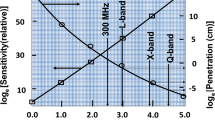Abstract
Electron Paramagnetic Resonance (NMR) and Nuclear Magnetic Resonance (NMR) discovered around the middle of the twentieth century became two of the fastest evolving spectroscopic techniques with applications starting in physics and slowly developing into playing important roles in structural organic chemistry, biology, solid state, medicine, and almost any field. NMR has been developing relatively faster than EPR due to reasons of large differences in their dynamics that will be detailed below. With the development of FT-NMR and diagnostic imaging with MRI, NMR kindled the efforts in the development of FT-EPR imaging attempts. With relentless efforts supported by the developments in electronics, fast switches, and narrow-line free electron spin probes, we are now in a position to routinely generate fast in vivo EPR images of small animals using time-domain EPR. EPR imaging holds a unique promise of quantitatively mapping the in vivo tissue oxygen distribution non-invasively. However, unlike MRI, EPRI requires the use of non-toxic bio-compatible paramagnetic spin probes. Many tumors are characterized by a hypoxic core that is highly resistant to radiation and chemotherapeutic treatment. EPRI enables fast quantitative non-invasive assessment and monitoring of tumor hypoxia. The present article is confined to the development of radiofrequency Time-domain EPR imaging developed at NCI, NIH, DHHS, USA, and some representative examples.













Similar content being viewed by others
References
P.C. Lauterbur, Image formation by induced local interactions: examples employing nuclear magnetic resonance. Nature 242, 190–191 (1973)
P. Mansfield, Multi-planar image formation using NMR spin echoes. J. Phys. C: Solid State Phys. C10, L55–L58 (1977)
J. Radon, P.C. Parks, On the determination of functions from their integral values along certain manifolds. IEEE Trans. Med. Imaging 5, 170–176 (1986)
D. Kumar, R.R. Welti, Ernst NMR fourier zeugmatography. J. Magn. Reson. 213, 495–509 (2011)
K.J. Liu, P. Gast, M. Moussavi, S.W. Norby, N. Vahidi, T. Walzak, M. Wu, H.M. Swartz, Lithium phthalocyanine: a probe for electron paramagnetic resonance oximetry in viable biologic systems. Proc. Nat. Acad. Sci. USA 90, 5438–5442 (1993)
A. Manivannan, H. Yanagi, G. Ilangovan, P. Kuppusamy, Lithium naphthalocyanine as a new molecular radical probe for electron paramagnetic resonance oximetry. J. Magn. Magn. Mater. 233(3), L131–L135 (2001)
S. Pfenninger, W. Froncisz, J. Forrer, J. Luglio, J.S. Hyde, General-method for adjusting the quality factor of EPR resonators. Rev. Sci. Instrum. 66(10), 4857–4865 (1995)
G.A. Rinard, R.W. Quine, S.S. Eaton, G.R. Eaton, Frequency dependence of EPR sensitivity, in EPR: instrumental methods: biological magnetic resonance, vol. 21, ed. by L.J. Berliner, C.J. Bender (Springer, Boston, MA, 2004)
J.H. Ardenkjaer-Larsen, I. Laursen, I. Leunbach, G.J. Ehnholm, L.G. Wistrand, J.S. Petersson, K. Golman, EPR and dnp properties of certain novel single electroncontrast agents intended for oximetric imaging. J. Magn. Reson. 133, 1–12 (1998)
K. Golman, I. Leunbach, J.H. Ardenkjaer-Larsen, G.J. Ehnholm, L.G. Wistrand, J.S. Petersson, A. Jarvi, S. Vahasalo, Overhauser-enhanced MR imaging (OMRI). Acta Radiol. 39(1), 10–17 (1998)
K.I. Matsumoto, S. Subramanian, R. Murugesan, J.B. Mitchell, M.C. Krishna, Spatially resolved biologic information from in vivo EPRI, OMRI, and MRI. Antioxid. Redox Signal. 9(8), 1125–1141 (2007)
N. Devasahayam, S. Subramanian, R. Murugesan, J.A. Cook, M. Afeworki, R.G. Tschudin, J.B. Mitchell, M.C. Krishna, Parallel coil resonators for time-domain radiofrequency electron paramagnetic resonance imaging of biological objects. J. Magn. Reson. 142(1), 168–176 (2000)
S. Subramanian, J.W. Koscielniak, N. Devasahayam, R.H. Pursley, T.J. Pohida, M.C. Krishna, A new strategy for fast radiofrequency CW EPR imaging: direct detection with rapid scan and rotating gradients. J. Magn. Reson. 186(2), 212–219 (2007)
R. Czoch, A. Francik, J. Indyka, J. Koscielniak, EPR spectrometer with rapid scan. Meas. Automatic Contr. 29, 41–43 (1983)
Hornak, J.P. The Basics of MRI; J.P. Hornak, 1996–2011; http://www.cis.rit.edu/htbooks/mri/. Accessed 5 Jan 2021
V.S. Subramanian, E. Boris, H.J. Halpern, Orthogonal resonators for pulse in vivo electron paramagnetic imaging at 250 MHz. J. Magn. Reson. 240, 45–51 (2014)
G.A. Rinard, R.W. Quine, L.A. Buchanan et al., Resonators for in vivo imaging: practical experience. Appl. Magn. Reson. 48, 1227–1247 (2017)
S. Emid, J.H.N. Creyghton, High-resolution NMR imaging in solids. Physica 128B, 81–83 (1985)
G.G. Maresch, M. Mehring, S. Emid, High resolution ESR imaging. Physica 138B, 261–263 (1986)
M. Lustig, D. Donoho, J.M. Pauly, Sparse MRI: the application of compressed sensing for rapid MR imaging. Magn. Reson. Med. 58, 1182–1195 (2007)
B. Epel, M.K. Bowman, C. Mailer, H.J. Halpern, Absolute oxygen R1e imaging in vivo with pulse electron paramagnetic resonance. Magn. Reson. Med. 72, 362–368 (2014)
P.L. Pedersen, Warburg, me and hexokinase 2: multiple discoveries of key molecular events underlying one of cancers’ most common phenotypes, the “warburg effect", i.e., elevated glycolysis in the presence of oxygen. J. Bioenerg. Biomembr. 39(3), 211–222 (2007)
Acknowledgements
This research was supported by the Intramural Research Program of the National Institute of Health at the Center for Cancer Research, where the work described herein was carried out over a period of 15 years. Several visiting Fellows and post-doctoral fellows were involved too numerous to thank individually and we thank all of them. The instrumentation help throughout the course of development from Mr. Nallathambi Devasahayam is gratefully acknowledged.
Author information
Authors and Affiliations
Corresponding author
Additional information
Publisher's Note
Springer Nature remains neutral with regard to jurisdictional claims in published maps and institutional affiliations.
Rights and permissions
About this article
Cite this article
Krishna, M.C., Subramanian, S. The Development of Time-Domain In Vivo EPR Imaging at NCI. Appl Magn Reson 52, 1291–1309 (2021). https://doi.org/10.1007/s00723-021-01369-4
Received:
Revised:
Accepted:
Published:
Issue Date:
DOI: https://doi.org/10.1007/s00723-021-01369-4



